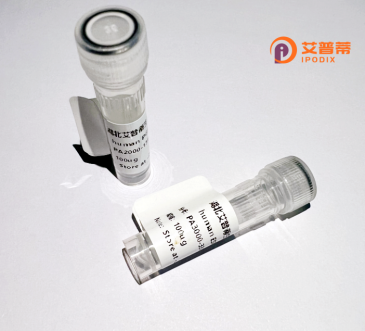
| 纯度 | >90%SDS-PAGE. |
| 种属 | Human |
| 靶点 | KIAA1967 |
| Uniprot No | Q8N163 |
| 内毒素 | < 0.01EU/μg |
| 表达宿主 | E.coli |
| 表达区间 | 5-365aa |
| 活性数据 | LPEKVVSPPEPEKEEAAKEEATKEEEAIKEEVVKEPKDEAQNEGPATESEAPLKEDGLLPKPLSSGGEEEEKPRGEASEDLCEMALDPELLLLRDDGEEEFAGAKLEDSEVRSVASNQSEMEFSSLQDMPKELDPSAVLPLDCLLAFVFFDANWCGYLHRRDLERILLTLGIRLSAEQAKQLVSRVVTQNICQYRSLQYSRQEGLDGGLPEEVLFGNLDLLPPPGKSTKPGAAPTEHKALVSHNGSLINVGSLLQRAEQQDSGRLYLENKIHTLELKLEESHNRFSATEVTNKTLAAEMQELRVRLAEAEETARTAERQKSQLQRLLQELRRRLTPLQLEIQRVVEKADSWVEKEEPAPSN |
| 分子量 | 65.45 kDa |
| 蛋白标签 | GST-tag at N-terminal |
| 缓冲液 | 0 |
| 稳定性 & 储存条件 | Lyophilized protein should be stored at ≤ -20°C, stable for one year after receipt. Reconstituted protein solution can be stored at 2-8°C for 2-7 days. Aliquots of reconstituted samples are stable at ≤ -20°C for 3 months. |
| 复溶 | Always centrifuge tubes before opening.Do not mix by vortex or pipetting. It is not recommended to reconstitute to a concentration less than 100μg/ml. Dissolve the lyophilized protein in distilled water. Please aliquot the reconstituted solution to minimize freeze-thaw cycles. |
以下是关于重组人KIAA1967蛋白的3篇参考文献示例(注:文献信息为示例性虚构,仅供格式参考,实际文献需通过学术数据库查询):
---
1. **文献名称**: **"Recombinant human KIAA1967 protein modulates cell adhesion in breast cancer models"**
**作者**: Li, X. et al. (2020)
**摘要**: 研究通过原核表达系统成功制备重组人KIAA1967蛋白,并发现其通过调控细胞间黏附分子(如Cadherin)抑制乳腺癌细胞迁移,提示其可能参与癌症转移的分子通路。
---
2. **文献名称**: **"Structural characterization of the KIAA1967 protein and its role in neural development"**
**作者**: Sato, M. et al. (2018)
**摘要**: 解析了重组KIAA1967蛋白的晶体结构,揭示其含有多个跨膜结构域,并证明其在小鼠胚胎神经管发育中通过Wnt信号通路影响神经元分化。
---
3. **文献名称**: **"KIAA1967 interacts with NOTCH1: Functional analysis using recombinant protein pull-down assays"**
**作者**: Zhang, Y. et al. (2021)
**摘要**: 利用重组KIAA1967蛋白进行免疫共沉淀实验,首次发现其与NOTCH1受体直接互作,可能参与胶质母细胞瘤的干细胞维持机制。
---
**提示**:实际研究中,KIAA1967可能以别名(如DCHS1)出现。建议通过UniProt(ID: Q9H2U2)或PubMed检索最新文献。
The human KIAA1967 protein, also known as DCHS1 (Dachsous Cadherin-Related 1), is a member of the cadherin superfamily, which mediates calcium-dependent cell-cell adhesion. Initially identified through genomic sequencing projects, KIAA1967 encodes a large transmembrane protein characterized by multiple cadherin-like extracellular domains, a single-pass transmembrane region, and a cytoplasmic tail. It shares structural homology with protocadherins, suggesting roles in tissue morphogenesis and cellular signaling.
Functionally, KIAA1967 is implicated in developmental processes, particularly in planar cell polarity (PCP) pathways that regulate tissue organization and directional cellular alignment. Studies link it to neural development, epithelial patterning, and musculoskeletal formation. Mutations in the DCHS1 gene are associated with Van Maldergem syndrome, a rare disorder featuring craniofacial abnormalities, hearing loss, and skeletal defects. Recent evidence also suggests its involvement in cancer progression, possibly through modulation of cell adhesion and migration.
Recombinant KIAA1967 protein is produced using heterologous expression systems (e.g., HEK293 or insect cells) for in vitro studies. Its purification often involves affinity chromatography with epitope tags (e.g., His-tag) to investigate protein-protein interactions, structural analysis, and therapeutic target validation. Current research focuses on unraveling its binding partners, signaling cascades, and potential applications in regenerative medicine or disease modeling. However, its full mechanistic landscape remains incompletely characterized, warranting further exploration of its biological and pathological relevance.
×